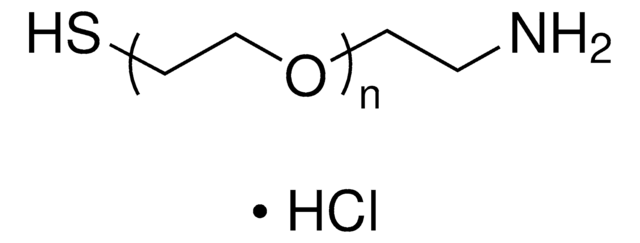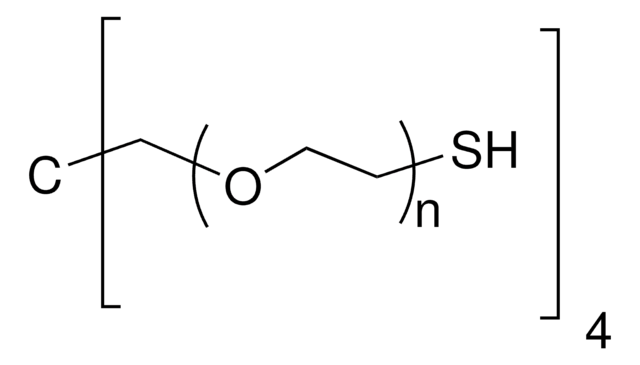729140
Poly(ethylene glycol) methyl ether thiol
average Mn 2,000, chemical modification reagent thiol reactive, methoxy, thiol
Sinónimos:
Polyethylene glycol, Methoxy PEG thiol, Methoxypolyethylene glycol thiol, PEG thiol, mPEG thiol
About This Item
Productos recomendados
Nombre del producto
Poly(ethylene glycol) methyl ether thiol, average Mn 2,000
form
solid
Quality Level
mol wt
average Mn 2,000
reaction suitability
reagent type: chemical modification reagent
reactivity: thiol reactive
mp
50-55 °C
Ω-end
thiol
α-end
methoxy
polymer architecture
shape: linear
functionality: monofunctional
storage temp.
−20°C
¿Está buscando productos similares? Visita Guía de comparación de productos
Categorías relacionadas
Application
- Surface modification of polyaniline nanorods with thiol-terminated poly (ethylene oxide): This study explores the use of varying molecular weights of poly(ethylene glycol) methyl ether thiol for modifying the surface of polyaniline nanorods, aiming to enhance their dispersibility and functionality (DiTullio et al., 2018).
- Colorimetric determination of p-phenylenediamine using silver nanoparticles modified with poly (ethylene glycol) methyl ether thiol: The research demonstrates the use of poly(ethylene glycol) methyl ether thiol in modifying silver nanoparticles for the colorimetric determination of p-phenylenediamine, showcasing its application in analytical chemistry (Lee et al., 2017).
- Facile synthesis and self-assembly of amphiphilic polydimethylsiloxane with poly (ethylene glycol) moieties via thiol-ene click reaction: This article discusses the synthesis and self-assembly of amphiphilic copolymers using thiol-ene click chemistry, emphasizing the versatility of poly(ethylene glycol) methyl ether thiol in creating functional materials (Xia et al., 2015).
- Determination of polyethylene glycol end group functionalities by combination of selective reactions and characterization by matrix assisted laser desorption/ionization time of flight mass spectrometry (MALDI-TOF MS): This study highlights a method for characterizing end group functionalities of poly(ethylene glycol) derivatives using MALDI-TOF MS, where poly(ethylene glycol) methyl ether thiol plays a critical role in the analysis process (Zhang et al., 2014).
signalword
Warning
hcodes
Hazard Classifications
Eye Irrit. 2 - Skin Irrit. 2 - STOT SE 3
target_organs
Respiratory system
Storage Class
11 - Combustible Solids
wgk_germany
WGK 3
flash_point_f
Not applicable
flash_point_c
Not applicable
Elija entre una de las versiones más recientes:
¿Ya tiene este producto?
Encuentre la documentación para los productos que ha comprado recientemente en la Biblioteca de documentos.
Los clientes también vieron
Nuestro equipo de científicos tiene experiencia en todas las áreas de investigación: Ciencias de la vida, Ciencia de los materiales, Síntesis química, Cromatografía, Analítica y muchas otras.
Póngase en contacto con el Servicio técnico












